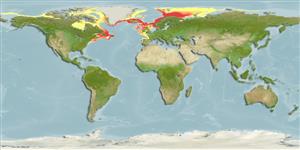Malacostraca |
Amphipoda |
Ampeliscidae
Environment: milieu / climate zone / depth range / distribution range
Ecology
Benthopelagic; depth range 92 - 835 m (Ref. 78173). Polar
Arctic; Northern Atlantic: Scandinavia to Britain and Nova Scotia to mid-Atlantic States.
Length at first maturity / Size / Weight / Age
Maturity: Lm ? range ? - ? cm
Found on continental shelf and slope. Feeding type is via deposit or suspension feeding (Ref. 87872).
Life cycle and mating behavior
Maturity | Reproduction | Spawning | Eggs | Fecundity | Larvae
Members of the order Amphipoda are gonochoric and sexually dimoprhic (males larger than females). Mating behavior: Males locate potential partners with the aid of their antenna to detect the pheromones released by the females; the male then rides or carries the female until the latter is ready to molt. When the female is ready, the male pushes the sperm into the marsupium and releases the female afterwards. A few hours later, the female releases her eggs into the marsupium for fertilization. Life cycle: Eggs are brooded in the marsupium. Eggs hatch into juveniles and remain in the marsupium for a few days. Each species undergo 20 molts at most, i.e., 1-year long life cycle.
Cusson, M., P. Archambault and A. Aitken. 2007. (Ref. 3448)
IUCN Red List Status (Ref. 130435)
CITES status (Ref. 108899)
Not Evaluated
Not Evaluated
Threat to humans
Human uses
| FishSource |
Tools
More information
Age/Size
Growth
Length-weight
Length-length
Morphology
Larvae
Abundance
Internet sources
Estimates based on models
Preferred temperature
(Ref.
115969): 0.6 - 7.9, mean 3.8 (based on 807 cells).
Price category
Unknown.
